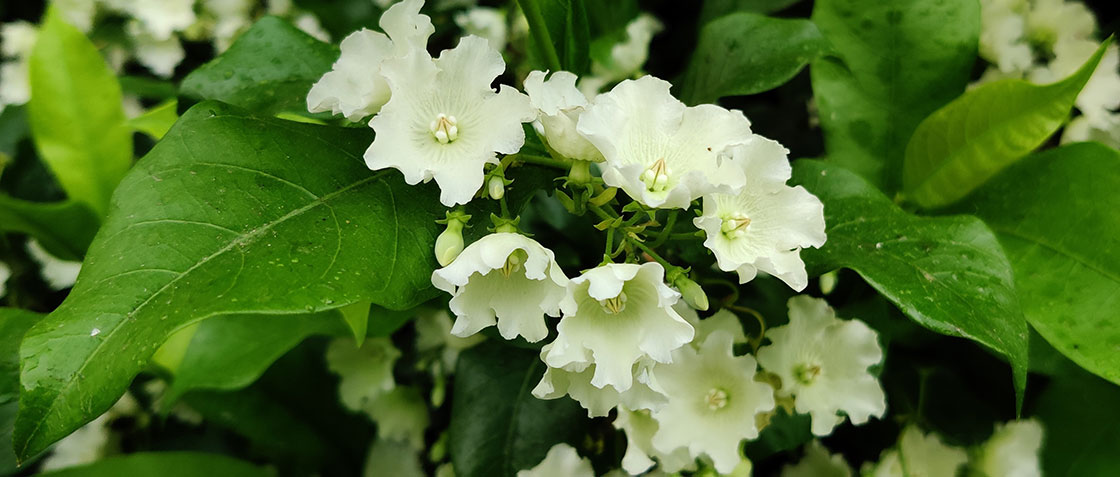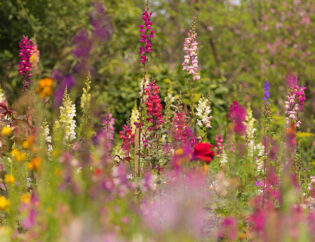
Those of us lucky to live in a house with a garden, feel blessed each time we spend time there. The green expanse and the colour of myriad flowers is a joy to behold for our senses. However, our garden experience cannot be complete without fragrance.
Fragrance is enticing. With a sweet smelling garden, it is a delight for the visitor to spend maximum time there. Many of the sweet, fragrant flowers do not have colour, so it is a good idea to plant them behind the colourful flowers and yet be delighted by the smell.
There are many plants which have beautiful fragrant flowers. Trees like Alstonia scholaris with its powerful, spicy smell in October to the annual flower like Allyssum with a mild floral fragrance. These plants, planted in any garden, big or small, are sure to delight the owner.
I will start with the fragrant trees first. Bungalows with large gardens can have a small grove of Alstonia scholaris or it can be planted at the entrance of the main gate. This is an evergreen tree with strong, sweet smelling, greenish flowers in the month of October. The smell is so powerful, that it can be smelt from a distance of 500 metres! The tree is large, and can grow up to 130 feet tall, so there should be ample space where there is full sun, for it to grow.
Albizia lebbeck or Siris is another large tree with a spreading habit. Its greenish white flowers, which appear in April, are fragrant and attract bees, butterflies and sunbirds. This should also be planted in full sun with lots of space.
Melia azedrakh is a medium sized tree, albeit with very brittle branches. It should be planted in full sun, away from pedestrians or seating areas. The sweet smelling flowers appear in beautiful, mauve clusters in March. This tree is great for hole nesting birds like barbets, parakeets and woodpeckers.
Mimusops elengi forms a dense crown of dark, evergreen leaves. Small groves in a large garden add a focal point and fragrance. The small, white, very fragrant flowers appear in May-June and another flush in the monsoons. The fruits are loved by birds and fruit eating bats.
One of the most loved small trees is the Har shinghar or Nyctanthes arbor-tristis. The beautiful, orange and white, scented flowers appear in late September to early October. This night blooming tree has flowers like a fallen carpet in the morning. The flowers are used in cooking for the beautiful saffron colour, to colour rice pilaffs.
Plumeria alba or the Frangipani is a small tree and famous for its fragrance and in Hawaii lai garlands are made from them. Summers and monsoons is when it flowers and the large leathery leaves are shed in autumn to winter
Clusters of these small trees, or along the driveway or boundary wall, these trees will add to the beauty of the home. Flowers along with fragrance to keep the spirits soaring!
There are a myriad of large and small shrubs with scented flowers which do well in the plains of North India. The famous “Raat ki raani” or the Cestrum nocturnum has a heady fragrance in the night. Planted next to your living room or bedroom window, the sweet fragrance of the night blooming flowers, will gently lull you to a peaceful mind. A myth is that snakes are attracted to it. That is a total myth! So please plant it strategic places to enjoy its heady fragrance.
“Din ka raja”, the day counterpart, Cestrum diurnum, has white tubular flowers which also have a sweet smell. These have fragrance during the day time, albeit, not as strong as the C.nocturnum. Butterflies and bees are attracted to the flowers.
No garden is complete without the summer flowering motia or mogra. The beautiful flowers of the Jasminum sumbac are made into garlands and sold on street sides throughout summers. The heat of the day seems to encourage more buds on the plant which bloom late in the evening or early the next morning. These white flowers have a gorgeous fragrance and full up the room where ever they are kept into a lightly scented chamber.
As the winters bid adieu, the shrubs of Acokanthera oppistifolia get covered with small, scented, cream coloured flowers. With the gentle breeze of February and March, the fragrance wafts through the garden. A sunny location is best for this shrub and round, black berries follow the flowering. Take care that children do not pluck and eat them, as they are very poisonous!
Mid spring onwards to mid monsoon, the lovely scented flowers of the waxy Gardenia jasmenoides bloom in the garden. They turn yellowish cream as they mature and fade. The shrub grows well in good soil, in dappled sunlight. A perfect setting for the evening drinks in the garden would be close to the gardenia bushes, whose waxy white, fragrant flowers would shine in moonlight.
Lawsonia inerme and Murraya paniculata are Mehndi and Kamini. The grey-green colours of the mehndi bush get greenish, small flowers from mid summers to monsoons. They have a lovely mild fragrance and the leaves can be dried to use as the famous henna. Both these bushes are great as hedge plants as well. A wall of murraya, with handsome dark, green leaves, bears beautiful waxy white fragrant flowers most of the year in profusion. A perfect “wall” to mask the water tank, generator, etc in a garden!
One of the most attractive shrubs in the garden is the Kumquat shrub. Citrus japonica has beautiful white flowers in spring with a lovely citrus fragrance. The raw fruit in summer is green, ripening to a gorgeous orange by winters. These orange balls are very attractive and the shrub does well in a sandy, loamy soil in sunlight. A most delicious candy, squash or marmalade can be made from it.
The spiny Rosa damescena does well in a sandy soil. Scented, pink flowers in winters cover the bushes. These are the famous roseflowers which give gulukand and the scent discovered by Noor jehan and distilled ittar from it!
Panandus odorattisimus is the famous “keora”. The strong, beautiful, scent pervades when in flower. This rather large, spiny, plant is good only for very large gardens, close to a water pond or garden drain. The large, creamish, flower spathes appear during monsoon and the male flowers produce the hallmark scent which is used in ayurveda, perfumery and cooking. In some cultures of India, wedding guests are also sprayed as a welcome with Keora water or rose water.
The best way to cover unsightly walls is with creepers. What could be better than creepers with fragrant flowers?
The Rangoon creeper or Combretum indicum has white scented flowers which mature into a beautiful dark pink colour. This heavy flowering creeper, blooms through the hot summer into monsoon, shedding its leaves in winters. It needs support to climb and blooms profusely once established. This fast growing plant is wonderful to cover unsightly walls, fence, etc.
In the month of late June, the fragrant buds of the Clematis ligusticifolia start appearing. The white flowers cover the bower or wall in profusion and bloom through the monsoon. This beautiful creeper is very suitable for walls, fences or arches. Every three to four years it can be pruned to approximately one foot above the ground.
The Trachelospermum jasmenoides is a popular evergreen creeper in Italy. Lots of buildings and arches are covered with it. Fortunately, it does wonderfully well in our plains. The dark green, handsome foliage bursts into star shaped small white, very fragrant, flowers in February- March. Also called the Star Jasmine, it’s a wonderful creeper for arches and pergolas.
The vigorous climber of Vallaris solanacea bears white, circular flowers in profusion from late January to late April. Also known as Bread flower, the fragrance is reminiscent of cooking basmati rice! The flowers attract lots bees, butterflies and other nectar feeders. It is suitable to cover large walls and fences.
No garden can be complete without the untidy, straggling, shrubby climber of the Jasminum grandiflorum. The favourite of the kings, queens and the elite, Chameli, as it is known in Hndutani, has been used to make a strong, oily ittar since centuries in India. The white flowers appear from august to October, covering the dark green foliage.
Along with the chameli, the juhi cannot be far behind. The small, white, sweet smelling flowers start blooming in spring right up to autumn. This is a straggly shrub, and best suited for corners close to a wall.
The vine of the malti or Aganosma heyei blooms with fragrant, white bunches of flowers from mid July to October. A sunny wall is best for this vigorous climber and it will quickly cover it.
A moonlight garden can be planned with the juhi, chameli, malti and raat ki raani, which the Mughals did. Imagine, moonlit nights, sitting in the garden with the heady fragrance wafting through the balmy air! An unforgettable experience it can be.
Small, fragrant, flowers can add to the fragrance experience in a garden of annuals in spring. Many sunny spaces, transform into a riot of colour in the spring of North India. Annuals in a myriad of colours can transform your balconies, patios, terraces or gardens into a riot of colour for two to three months. Why not add fragrance to your space?
The bulbs of Narcissus bloom in December to January with sweet smelling flowers while tuberoses bloom in early summer till late in the year. The spring garden can be planted with fragrant sweet peas, stocks, alyssum, carnations and petunia.
A garden, howsoever big or small, is a joy forever. Along with colour, we should add fragrance to make a garden complete experience.

